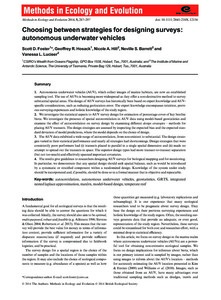| dc.contributor.author | Foster, Scott D. | |
| dc.contributor.author | Hosack, Geoffrey R. | |
| dc.contributor.author | Hill, Nicole A. | |
| dc.contributor.author | Barrett, Neville S. | |
| dc.contributor.author | Lucieer, Vanessa L. | |
| dc.date.accessioned | 2018-06-27T20:39:56Z | |
| dc.date.available | 2018-06-27T20:39:56Z | |
| dc.date.issued | 2014 | |
| dc.identifier.citation | Foster, S.D.; Hosack, G.R.; Hill, N.A.; Barrett, N.S. and
Lucieer, V. (2014) Choosing between strategies for designing surveys: autonomous underwater vehicles. Methods in Ecology and Evolution, 5, pp.287–297. DOI: 10.1111/2041-210X.12156 | en_US |
| dc.identifier.uri | http://hdl.handle.net/11329/440 | |
| dc.identifier.uri | http://dx.doi.org/10.25607/OBP-26 | |
| dc.description.abstract | 1. Autonomous underwater vehicles (AUV), which collect images of marine habitats, are now an established
sampling tool. The use of AUVs is becoming more widespread as they offer a non-destructive method to survey
substantial spatial areas. The design of AUV surveys has historically been based on expert knowledge andAUVspecific
considerations, such as reducing geolocation error. The expert knowledge encompasses intuition, previous
surveying experiences and holistic knowledge of the study region.
2. We investigate the statistical aspects to AUV survey design for estimation of percentage cover of key benthic
biota. We investigate the presence of spatial autocorrelation in AUV data using model-based geostatistics and
examine the effect of autocorrelation on survey design by examining different design strategies – methods for
placing AUV transects. The design strategies are assessed by inspecting the expected bias and the expected standard
deviation ofmodel predictions, where the model depends on the choice of design.
3. The AUV data exhibited a wide range of autocorrelation, from non-existent to substantial. The design strategies
varied in their statistical performance and nearly all strategies had shortcomings. Design strategies that were
consistently poor performers had (i) transects placed in parallel in a single spatial dimension and (ii) made no
attempt to spread out the transects in space. The superior design types had more transect-to-transect separation
(but not toomuch) and effectively spanned important covariates.
4. The results give guidelines to researchers designing AUV surveys for biological mapping and for monitoring.
In particular, we demonstrate that any spatial design should seek spatial balance, such as would be introduced
by a systematic or stratified component within a randomized design. Knowledge of the system under study
should be incorporated and, if possible, should be done so in a formalmanner that is objective and repeatable. | en_US |
| dc.language.iso | en | en_US |
| dc.subject.other | AUV | en_US |
| dc.subject.other | Atonomous underwater vehicles | en_US |
| dc.subject.other | Autocorrelation | en_US |
| dc.subject.other | Geostatistics | en_US |
| dc.subject.other | GRTS | en_US |
| dc.subject.other | Integrated nested laplace approximation | en_US |
| dc.subject.other | Matern | en_US |
| dc.subject.other | Model based design | en_US |
| dc.subject.other | Temperate reef | en_US |
| dc.title | Choosing between strategies for designing surveys: autonomous underwater vehicles. | en_US |
| dc.type | Journal Contribution | en_US |
| dc.description.refereed | Refereed | en_US |
| dc.format.pagerange | pp.287-297 | en_US |
| dc.identifier.doi | 10.1111/2041-210X.12156 | |
| dc.bibliographicCitation.title | Methods in Ecology and Evolution | en_US |
| dc.bibliographicCitation.volume | 5 | en_US |
| dc.description.sdg | 14.2 | en_US |
| dc.description.bptype | Guide | en_US |
 Repository of community practices in Ocean Research, Applications and Data/Information Management
Repository of community practices in Ocean Research, Applications and Data/Information Management
